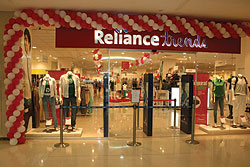With retail giants like Wal-Mart Stores Inc and Carrefour circling India in anticipation of a rule change that would allow foreign investment in supermarkets, Asia's richest man is scrambling to capitalise on his early mover advantage. Over the past few months, Reliance has accelerated store openings, brought in a management team from Wal-Mart China and launched wholesale operations that serve the small mom-and-pop players dominating the $450 billion Indian retail sector.
It has also rolled out its first large-format hypermarket outlets selling everything from food to furniture."In retail they are still a long way off," said Michiel van Voorst, portfolio manager for Asia-Pacific equities at Robeco Hong Kong, which is considering buying into the stock it sold off three years ago, tempted by its 22 percent decline in 2011."The business will still require a lot of investments, and there is no synergy to any of other activities of the company," said van Voorst, whose firm manages $2 billion in Asia.
 |
 |
Reliance battles the same problems that have thwarted faster growth for organised retail in Asia's third-largest economy, including expensive real estate and opposition from politically powerful small shop-owners, farmers and middlemen. At the launch of the retail arm in 2006, the energy-focused conglomerate had set out to build a $20 billion-revenue business by 2011. For fiscal 2011 ending March 31, however, retail sales were just 56.77 billion rupees ($1.1 billion), according to two analysts' estimates, an increase of 27 percent, but a tiny share from the group's total haul of $53 billion. The company acknowledges its retail business is loss-making but declined to verify those figure.
Reliance is the country's second-largest retailer by sales behind Future Group's Pantaloon Retail, but its overall market share is small in a country where more than 90 percent of the industry is made up of mom-and-pop stores. After launching operations in November 2006, it grew to about 1,000 stores within three years, but soon found it did not have the systems and infrastructure to support that expansion. Staff attrition, poor locations, supply-chain issues and infrastructure problems prompted it to shut nearly 50 stores within two years of the launch. Since then, the company has standardised its operations and increased centralisation of its supply chain. "During the 2008 slowdown, we thought we were insulated but we have learnt a lot from what we did," Bijou Kurien, chief executive of Reliance Retail's lifestyle arm, told Reuters.
Reliance's supermarket push hit major hurdles in 2007 and 2008, when it was chased out of the states of West Bengal, Jharkhand and Uttar Pradesh, India's most populous region, after protests by small-shop owners and farmers. Reliance still does not have supermarkets in Uttar Pradesh, which was supposed to generate 15 percent of its retail revenue by 2011. It also lacks a major store presence in eastern India. The standalone "kirana" shops, or neighbourhood mom-and-pop stores, and street-side vendors where most Indians buy groceries are popular because they are convenient and give credit. They also operate with little overheads, forcing chains to compete on razor-thin margins. Still, some of Reliance's local rivals including Pantaloons and Shopper's Stop have managed to make a profit, helped by a compact network of stores. "The idea is to expand and make money in every store that we set up, and that would be the way in which we scale the business," Kurien said.
To jumpstart its retail business, Reliance recently brought in Wal-Mart China's former chief operating officer Rob Cissell to head its supermarkets, along with his ex-colleague Shawn Gray, making up the retailer's third management team since 2006. Its original management was replaced in 2009 with a team of expatriates led by Gwyn Sundhagul from Tesco Lotus in Thailand. He now works in another Reliance business."We are now going into a phase of execution," a senior executive at Reliance Retail said on condition of anonymity as he is not authorised to speak to the media. "Our hypermarket initiative is now being driven by someone who has done this earlier in China, which is a similar market", he says. The changes at the top coincide with an expansion push that saw it open 60 stores in the last quarter, including its first two hypermarkets, which opened recently. That brought its overall store count to about 1,050. The large-format stores are between 60,000 and 100,000 square feet and by next year will be supported by distribution centres in Delhi, Bangalore and Pune. "The quality and efficiencies are much higher. The margin mix improves considerably. Small stores bring you visibility, but you need the big boxes for balance," the executive said. Reliance recently opened its first cash-and-carry, or wholesale, store in Ahmedabad, entering a format which Wal-Mart has already tried with six such outlets in India through a joint venture with the parent of telecoms firm Bharti Airtel. "We have also realised that 'kirana' stores will continue to coexist, so why not supply to them? It is an opportunity and we will not leave any opportunity," the Reliance official said.
Supermarkets account for 65 percent of Reliance's retail business, while specialty shops including local tie-up with global brands like Marks & Spencer, and Diesel make up the rest. "Their big gap is how to stabilise and run the operations. They have to stick to one plan and move, and that is their biggest challenge," said Pinakiranjan Mishra, head for consumer products and retail at advisory firm Ernst & Young. "If you change the model every one-and-a-half, two years and if you change the team, everything has to be reset," he said.
—Courtesy Reuters
|